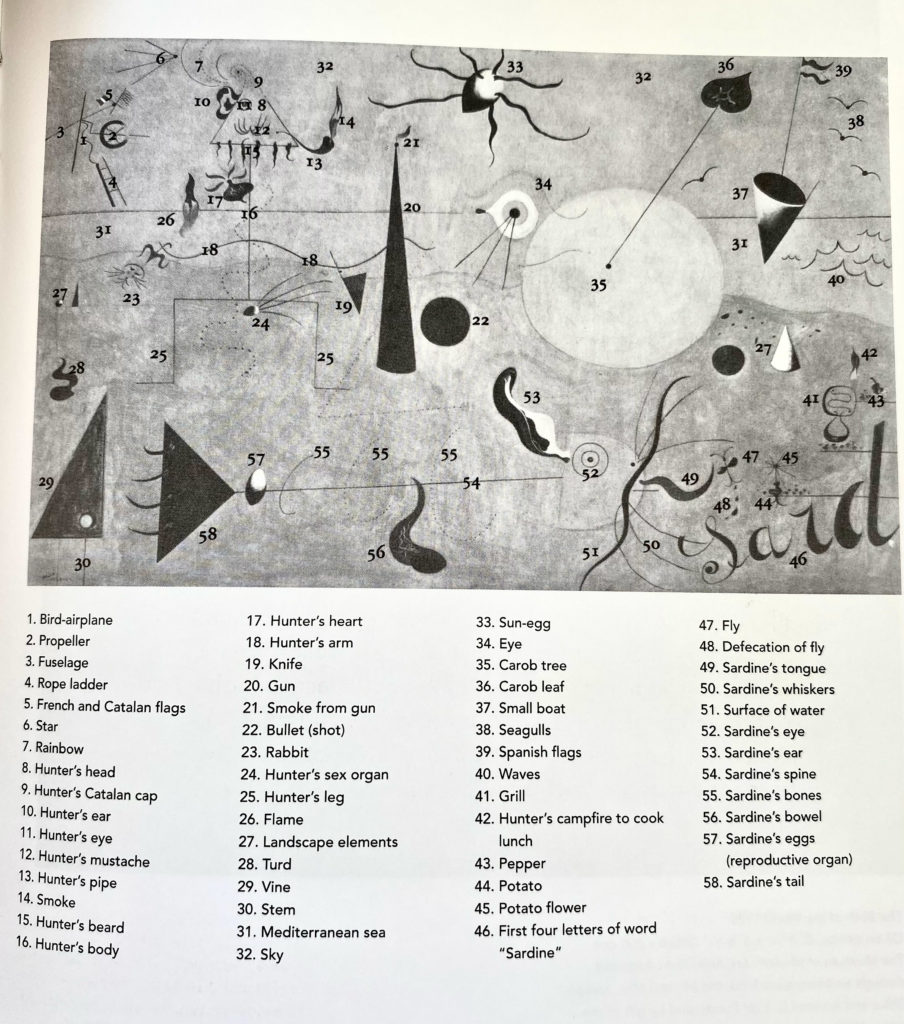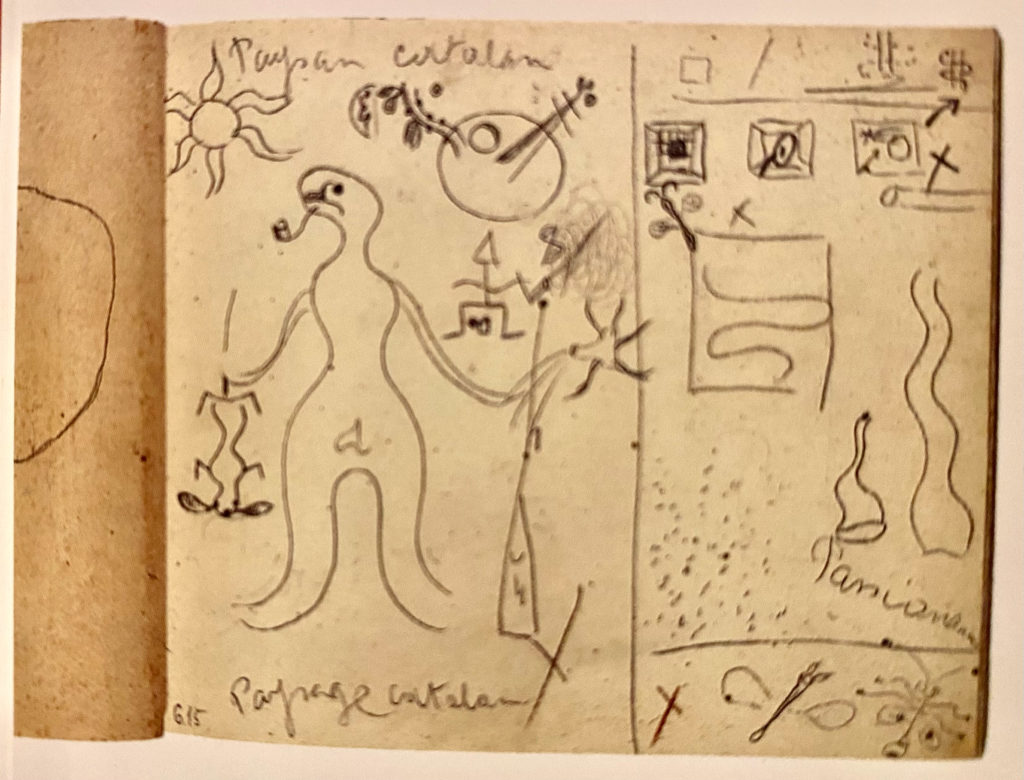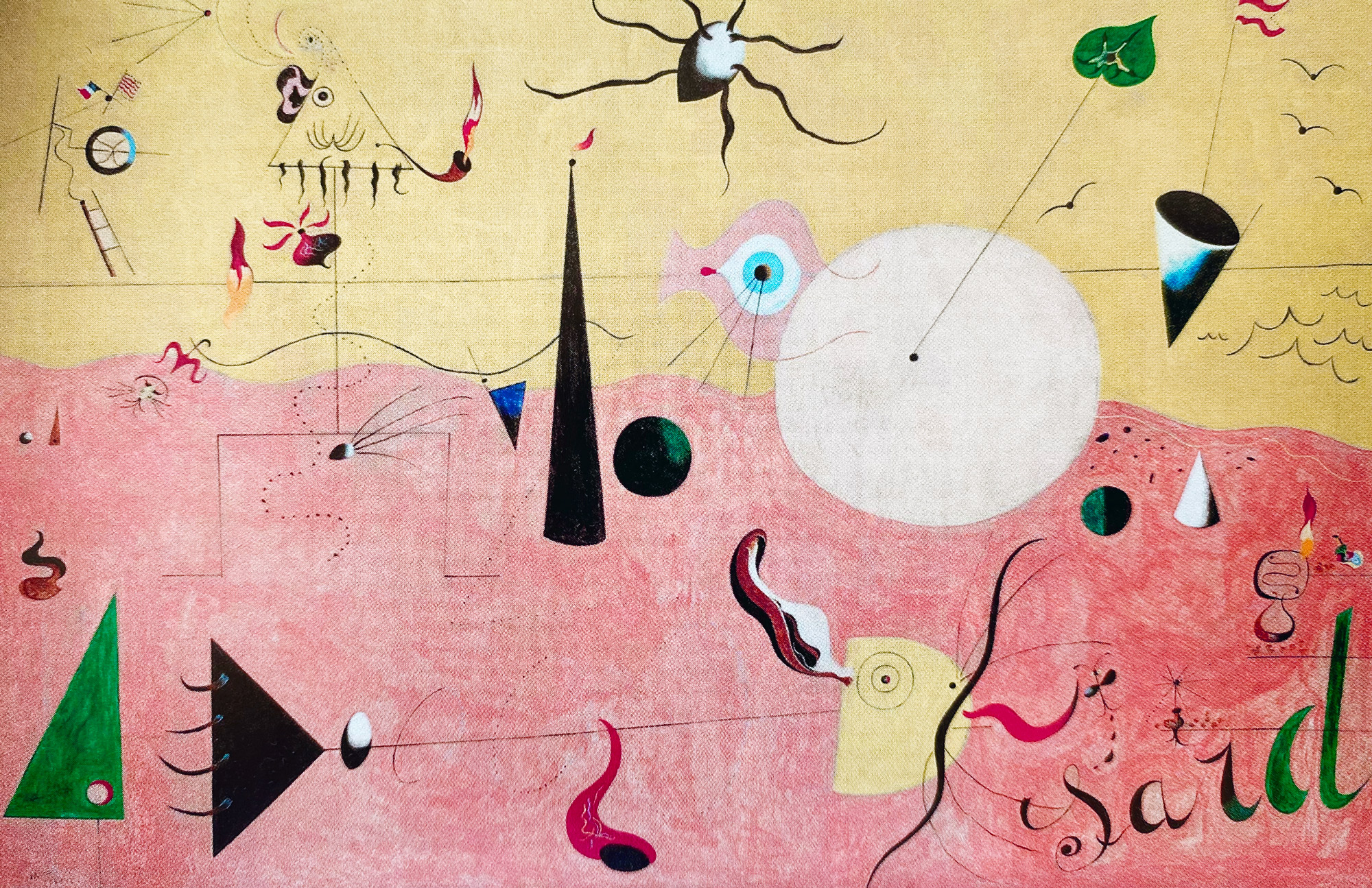Podcast version of this piece
Joan Miró’s painting The Hunter (Catalan Landscape) feels like a treasure hunt for hidden symbols. Their meaning wasn’t explained by the master until 30 years after he painted it. That was when Miró shared a diagram with New York’s Museum of Modern Art. It explained each detail of the landscape with surprises and whimsy. He also shared preliminary sketches with the MOMA that reveal the tangible origins behind his curious abstractions.
Miró’s Glossary

Not So Abstract After All
The primary example of this is the hunter from the title. In Miró’s pencil sketch we find a sloppy pipe smoker with liquid limbs. He also drew a graffiti-like organ on this floppy gentleman. It hangs parallel to a dead rabbit he holds up by the feet right beside his groin. We can see from the orderly nature of this seemingly abstract landscape that Miró had specific meaning in mind when he painted it. But it wasn’t until his explanatory diagram of 1959 that we got confirmation of this.
The Hunter (Catalan Landscape) brings together cosmic and grounded worlds… when we look at the canvas and away from Miró’s glossary. Water joins the pale yellow sky above a candy pink landscape where shapes, letters, and objects dance. It’s both familiar and unfathomable. We recognize an eyeball floating next to the enormous white orb on our right with a cone shape hovering nearby.
In the diagram we learn that this eyeball perches beside a carob tree and that the cone is actually a small boat traveling across the Mediterranean sea. These details are virtually impossible to read (except the eyeball) without Miró’s explanation. But his surreal whimsy is unmistakable. Of the eye, Miró said it represents the eye of the painting gazing at him, the painter. He brought the viewer into the canvas as part of the artwork this way.
LadyKflo’s YouTube Summary
Puzzle, Parable, or Portrait
It’s as if Miró has given his masterwork the power of sight, opening up a world of possibility for the way people relate to art. The Hunter (Catalan Landscape) can feel like a puzzle, a parable, or a portrait. Even with his lengthy diagram of explanation, it’s a canvas full of possibilities. I love how Miró starts a word on our lower right corner of the painting. For us, it only says sard and then he drops off the rest so we can finish the word how we like. But thanks to his diagram, we now know it begins the word sardine.
When I learned that this was the rest of the word at the bottom, it helped me understand Miró and his magical perspective. He was fascinated by the unconscious and channeled that into his work. That’s why this painting feels integrated and thematic even though on the surface it might seem random. Behind it, there’s a landscape with tangible symbols. But even more powerful are the familiar connections embedded into the painting – like an unconscious narrative. Sardine as a word and many sardine elements sprinkle around the Mediterranean sea and a small boat on our right.
Miró’s Sketch

Meanwhile on the left side. a macho hunter with a mustache poses holding a dead rabbit. He’s got every manly accessory imaginable: pipe, beard, knife, gun, and bullet. So, Miró gives us an earthy, manly world on this half of The Hunter (Catalan Landscape). By contrast, the right side of this canvas rocks on the waves of silver fish and whiskers in the water. Between these two sides he includes elements of air: there’s a fly and its defecation as well as the sun egg at the top near the center and the sky beside it.
Miró built a symbolic world into this canvas. When you see it in person, it feels larger than actual size. In fact, I found it hard to believe it was only about two by three feet. There’s so much packed into this landscape; it feels like it spreads across a vast swath of earth, sea, and sky. Miró often gives this impression with his work because he draws us in so deep that viewers can get a bit lost in his unconscious worlds. Wandering adrift in The Hunter (Catalan Landscape) feels just fine, though, because Miró keeps surprising us and making us laugh along the way.
The Hunter (Catalan Landscape) – FAQs
Where is The Hunter (Catalan Landscape) located?
Joan Miró’s painting The Hunter (Catalan Landscape) takes place at his home on the family’s farm in Montroig, Catalonia, Spain. This area is an autonomous part of the country. Catalonia has its own character, culture, and politics.
Miró portrayed a symbolic assortment of animals, human elements, and natural forms to represent his unconscious memories from growing up there.
What inspired Joan Miró?
Miró found great inspiration in doodling. He was impetuous and spontaneous when he created artwork and placed high value on his unconscious creations. Miró’s whimsy and natural humor spring from this and draw the viewer into the painting with charming delight and curiosity.
Enjoyed this analysis of The Hunter (Catalan Landscape) by Joan Miró?
Check out LadyKflo’s essays on other Spanish masters.
Sources
See The Hunter (Catalan Landscape) at MOMA
Margit Rowell, Joan Miró: Selected Writing & Interviews, Da Capo Press Inc; New edition (1 August 1992)
Stephan von Wiese Painting as Universal Poetry – the connection of painting and word in Miró. In Joan Miró – Snail Woman Flower Star Prestel, 2006
Jacques Lassaigne, Miró: biographical and critical study. Tr. Stuart Gilbert. (Paris: Editions d’Art Albert Skira, 1963)
Depression and the spiritual in modern art: homage to Miró Joseph J. Schildkraut, Aurora Otero. Chichester [England]. 1996.
Hemingway, Ernest. The Farm. Homage to Joan Miró. Ed. G. di San Lazzaro. New York: Tudor Publishing Company, 1972.
Umland, Anne. “A Challenge to Painting: Miró and Collage in the 1920s.” Joan Miró. Ed. Agnes De la Beaumelle. London: Paul Holberton Publishing, 2004.
